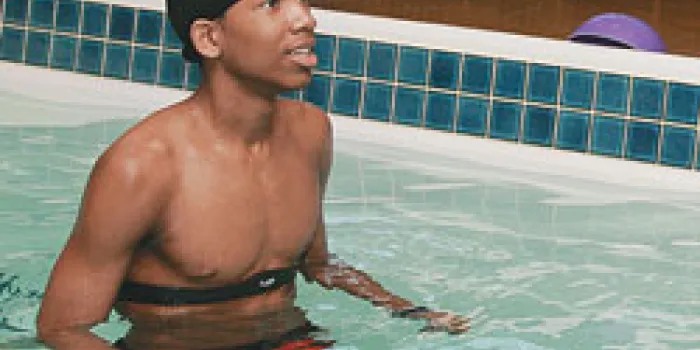For ages, Campbell Eccles has had his mind set on one thing: joining the cast of Endurance, a Survivor-like reality show for teens on the Discovery Channel. But at age 14, Campbell, like many kids his age with a bleeding disorder, exercised rarely and was out of shape.
According to the Centers for Disease Control and Prevention (CDC), teens ages 13–19 with bleeding disorders are almost twice as likely to be overweight than their peers. Those extra pounds put extra pressure on joints and muscles, and that can mean more frequent bleeds.
“More than 80 percent of bleeds are in joints. A strong preventive measure for such bleeds is exercise,” says Ann-Marie Nazzaro, PhD, National Hemophilia Foundation (NHF) vice president for education. “Overwhelmingly, though, youths with bleeding disorders say that they refrain from physical activity.”
With help from the CDC, Nazzaro and NHF developed “Do the 5!” tips for better health and prevention. Along with recommending annual checkups, hepatitis A and B vaccinations, early treatment of bleeds and routine monitoring for blood-borne infections, the plan stresses the need to exercise regularly and to maintain a healthy weight.
“The two messages that are most germane are that exercise builds muscles and protects joints, and that maintaining a healthy weight reduces stress on joints,” says Nazzaro.
Nazzaro and her team have taken this message to hemophilia treatment centers (HTCs) and NHF chapters around the country to build awareness—not only of the benefits of exercise and good nutrition—but also of the scope of the problem facing young people with bleeding disorders.
“In 2005, the CDC looked at data on the bleeding disorders community. They found that it is very overweight or obese, especially teens and young adults,” Nazzaro says.
“In people’s minds, exercise is not equated with prevention, but it needs to be. We want to press that issue,” says Nazzaro.
A Family Affair
Another program conveying that message is L.I.F.E. for Kids. Based at Peyton Manning Children’s Hospital at St. Vincent in Indianapolis, the yearlong fitness and nutrition program, launched in the spring of 2007, has changed Campbell Eccles’ life.
Eight months into the program, Campbell, now 15, has lost nearly 40 pounds. He is at the gym most days, lifting weights and running on the track. He has given up soda. He is even eating some vegetables.
“Before we joined the gym, we walked in the neighborhood and did ab crunches on the living room floor,” said Zach Eccles, Campbell’s father and exercise partner. He is also 40 pounds slimmer.
The program begins with weekly meetings to discuss and set nutrition and exercise goals. Changes in diet and exercise habits are introduced gradually.
“We don’t do anything crazy or drastic,” says program founder Lori Walton, RN.
“We give out elastic stretch bands for strength training,” says Walton. “We also give them pedometers so that they can measure their daily step count. If they start at 5,000, we want them up to 6,000. From there, patients can pick from a lot of different activities, depending on their interests and abilities.”
One key to the program is family participation.
“If Mom and Dad don’t change their habits, their kids won’t either,” says Michele Rice, executive director of Hemophilia of Indiana, an NHF chapter in Indianapolis. She is the mother of two sons in the program. “It floors me now to think that we have been drinking nothing but skim milk for six months, not to mention the healthy cereals, low-fat cheese and whole-wheat bread we are now eating.”
Against the Current
Jeff Kallberg, PT, runs a different kind of program at ACCUA Advanced Fitness Center near Minneapolis. He has severe hemophilia A, yet that did not stop him from earning a black belt in tae kwon do. He uses his personal experience to inspire others. As a physical therapist, he likes to challenge his patients with hemophilia to achieve fitness goals they never believed they could reach or were afraid to attempt.
“When they come here, they are often not even sure how to exercise,” says Kallberg.
After administering a battery of tests to determine fitness and abilities, Kallberg works with his patients individually to design a program that will be both motivating and challenging.
“We exercise together,” he says. “With that supervision, I can push them a little harder than they would push themselves at home.”
The centerpiece of ACCUA, which Kallberg co-founded, is its HydroWorx™ pool and its low-impact underwater treadmill. With their bodies submerged from their chest down, users run—even sprint—on a moving belt that’s built into the pool’s floor. Jets of water create an adjustable current that ranges from 1.5 mph to 8 mph.
“By building the current, we can make the workout harder and harder, yet it remains easy on the joints,” says Kallberg. “We train everyone from patients with hemophilia to professional athletes on the HydroWorx.”
One of those patients is Bobby Strom, 25. Like Kallberg, Strom has severe hemophilia A. Until a year ago, exercise was a foreign concept to him.
“I’d never run in my life—I never could,” says Strom. “But I can get in that pool and run. I’ve sprinted in that pool, and I never thought I would ever sprint. I used to think that exercise would only give me bleeds, but I’ve found out that most of my joint pain was from me not doing anything, from not exercising. Jeff has really changed my life.”

